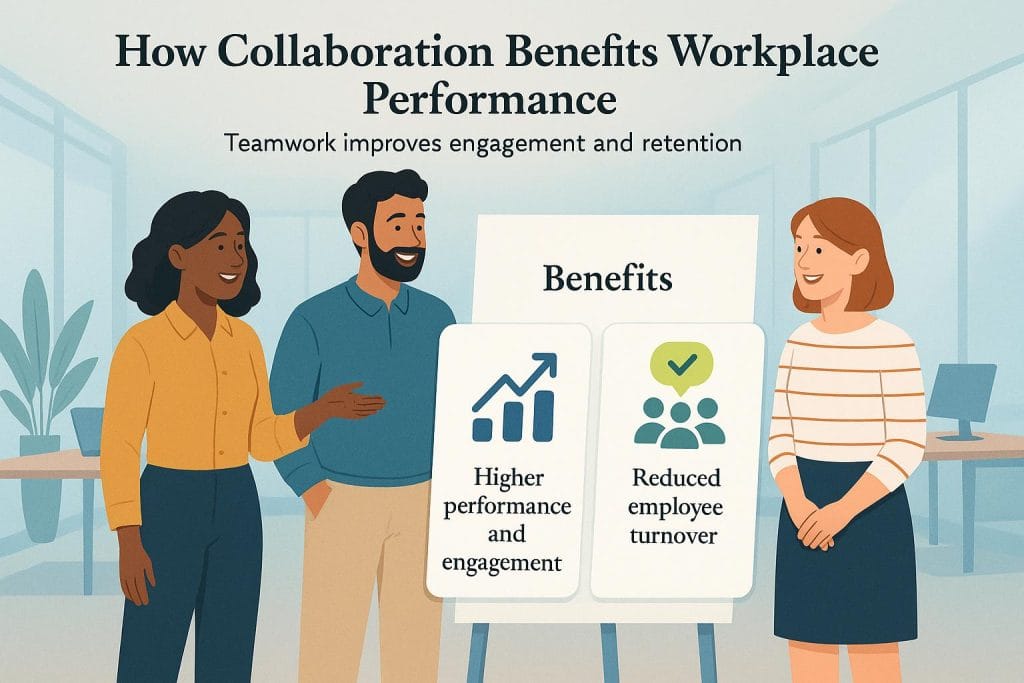Business.com aims to help business owners make informed decisions to support and grow their companies. We research and recommend products and services suitable for various business types, investing thousands of hours each year in this process.
As a business, we need to generate revenue to sustain our content. We have financial relationships with some companies we cover, earning commissions when readers purchase from our partners or share information about their needs. These relationships do not dictate our advice and recommendations. Our editorial team independently evaluates and recommends products and services based on their research and expertise. Learn more about our process and partners here.
Collaboration Improves Workplace Performance. Here’s How to Encourage It
Collaboration improves workplace performance. Here’s how to encourage it.

Table of Contents
Workplace collaboration often makes the difference between happy, engaged employees and bored, unproductive ones. If you want employees to reach their maximum potential, you must create an environment filled with healthy collaboration. This guide explains the significant benefits of collaboration and provides tips for encouraging it in the workplace.
How to encourage employee collaboration in the workplace
Building strong collaboration doesn’t happen by accident: It takes intention and the right culture. Here are some practical ways to help your team work better together and boost overall engagement.
Encourage teamwork as part of your company culture.
Many companies still measure success with traditional performance management systems that focus on individual performance. However, the most successful ones recognize that teamwork fuels real results. While it’s important to recognize individual contributions so employees feel appreciated, companies shouldn’t overlook the power of rewarding collaboration and workplace teamwork.
Make collaboration a core part of your company culture. Set the expectation that teamwork isn’t optional — it’s how your business operates — and remind employees that every team member plays a vital role in achieving shared success.
Leverage employee strengths.
Building an effective, collaborative team starts with understanding each person’s unique strengths. Managers need a clear view of what every team member brings to the table, including their expertise, interests and growth areas.
Encourage employees to lean into their strengths whenever possible. When people do work that aligns with their skills, they’re more productive, produce higher-quality results and feel more satisfied with their contributions.
When managers understand their team’s diverse capabilities, they can form complementary groups where members naturally support one another. That way, when someone encounters a challenge outside their comfort zone, they’ll know exactly who to turn to, strengthening collaboration and trust across the team.
Do away with competitive performance ratings.
If your company still relies on traditional performance ratings, it may be time to try something new. Ranking employees may seem fair, but it rarely motivates people and can seriously hurt collaboration. When staff feel like they’re competing with one another or fear losing their jobs to higher-rated co-workers, teamwork can’t help but break down.
Today’s best performance management trends focus on continuous feedback and growth-minded conversations. Regular one-on-one check-ins give employees a safe space to talk about goals, challenges and ways to work better together, without worrying about being compared to their co-workers.
Unite employees with your company’s values.
Clear company values lay the groundwork for genuine collaboration. When employees share the same principles and understand what the business stands for, they’re more likely to work together toward common goals.
A company that lives its values naturally attracts like-minded people who feel connected by a shared sense of purpose and community. That unity makes teamwork easier and more meaningful, so it’s worth investing time in defining and reinforcing your core values.
Be transparent with company goals, and show employees how they contribute.
Collaboration starts at the top. To foster a culture of business transparency, be clear about your business goals, challenges and direction so employees understand the bigger picture. When leaders communicate openly, it shows team members that their input matters and that they’re trusted partners in the company’s success.
With that context, employees can make smarter daily decisions that align with company objectives, and collaboration becomes part of how the business naturally operates.
Give your employees the software they need to communicate and collaborate.
The right tech tools and internal communication apps make collaboration easier. For example, Slack messaging is a great way for employees to share ideas, ask questions and offer quick feedback in real time. Performance management software can also support collaboration by scheduling and tracking one-on-one meetings between managers and team members.
When everyone has the tools to communicate openly and stay aligned on goals, feedback becomes part of the everyday workflow, not just an annual review topic.
How collaboration benefits workplace performance

Companies that make collaboration a priority see the difference in their results. When employees work well together, performance improves across nearly every metric, from increased productivity and innovation to better employee engagement and retention. Here are some of the biggest ways collaboration drives business success.
1. Collaboration improves workplace performance and engagement.
Research consistently shows that collaborative teams outperform siloed departments. According to a 2024 study by the Institute for Corporate Productivity (i4cp), companies that intentionally strengthen collaboration across teams see up to a 39 percent increase in productivity. The research found that effective “precision collaboration” — aligning the right people, processes and tools — unlocks measurable performance gains and fosters new business skills across the organization.
“Encouraging collaboration is a great way to get your employees more engaged as they’re working together more than they normally would on a common goal,” explained Kyle MacDonald, vice president of marketing and business development at Mojio. “While working with employees they may not normally work with, there’s also the opportunity to expand their skill sets and learn new skills from different teams — all at no cost to the company.”
2. Collaboration helps reduce employee turnover.
When collaboration and communication are part of everyday culture, employees are more likely to stay and feel satisfied at work. SHRM’s 2025 State of the Workplace Report lists teamwork and collaboration among the top drivers of employee retention and a good employee experience. The report also found that experience and engagement together account for 42 percent of turnover intent, and that one in four workers pointed to poor collaboration or team support as a major challenge.
In other words, when organizations strengthen collaboration, they don’t just improve morale — they help employees stay longer and perform better.
James Lloyd-Townshend, chairman and CEO of Tenth Revolution Group, noted that disagreement is an often-overlooked part of collaboration.
“We all have different perspectives and ideas, so it’s unrealistic to expect every discussion to flow smoothly to an ideal outcome,” Lloyd-Townshend explained. “But your staff need to feel supported and comfortable enough to contribute safely to the collective conversation. This means fostering an environment where everyone has a chance to voice their opinion. So, while social collaboration tools are useful, it’s the culture and relationships within a workplace that make the biggest difference in achieving successful collaboration.”
3. Collaboration improves morale.
In a collaborative environment, employees feel more energized and confident sharing ideas, especially when those ideas are welcomed and acted on. This kind of atmosphere helps create a happier and motivated workplace where morale thrives.
“Collaboration benefits businesses because team members can motivate each other through shared ideas, and ultimately have a positive impact on each other’s productivity,” explained Adam Rossi, owner of TotalShield. That positivity can ripple through the entire organization.
Research backs this up. The 2024 Zoom Global Collaboration Report found that when communication breaks down, 41 percent of employees and 32 percent of leaders experience frequent misunderstandings, and about a third say poor collaboration causes team misalignment. These issues don’t just create confusion — they sap motivation and morale. The study also revealed that inefficient collaboration costs companies more than $16,000 per manager each year in lost productivity.
The 2025 Microsoft Work Trend Index reached a similar conclusion from a different angle. It found that “Frontier Firms” — organizations that break down silos, foster collaboration and integrate human-AI teamwork — are nearly twice as likely to say their companies are thriving compared to the global average. Employees at these firms are also more likely to find their work meaningful and engaging — two qualities that directly fuel morale.
4. Collaboration strengthens remote and hybrid teams.
If you have a hybrid or remote work plan, collaboration can be even harder to sustain. Without day-to-day interaction, employees may feel disconnected or misaligned, challenges that can quickly erode morale and performance. However, fostering strong collaboration across locations helps bridge those gaps, creating connection, trust and shared purpose no matter where employees work.
“In order to keep everyone informed, coordinated and connected, it is even more important to encourage cooperation and engage distant teams,” said Vincent Amodio, CEO of Icon Medical Centers. “When workers who are physically separated from one another start to feel alone and lonely, it has a chilling effect on their motivation, creativity and commitment.”
The Zoom report cited above highlights these barriers, showing how communication breakdowns and a lack of alignment can undermine teamwork across distributed teams. Many companies respond in simple ways to boost collaboration, with fewer long meetings, more quick check-ins, and tools that make it easy to share ideas and stay connected.













